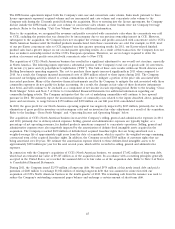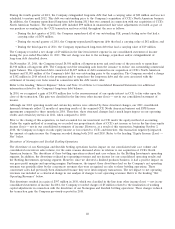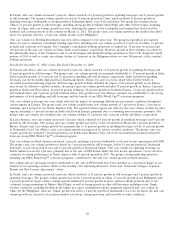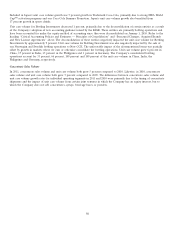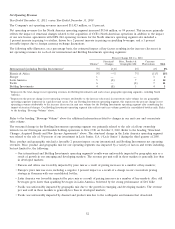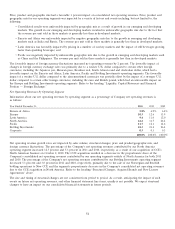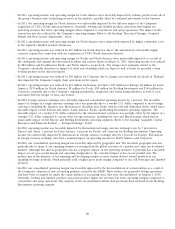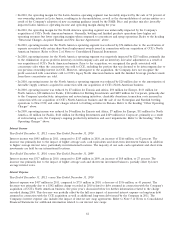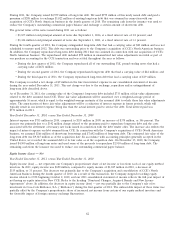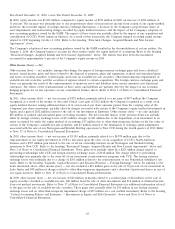Coca Cola 2011 Annual Report Download - page 57
Download and view the complete annual report
Please find page 57 of the 2011 Coca Cola annual report below. You can navigate through the pages in the report by either clicking on the pages listed below, or by using the keyword search tool below to find specific information within the annual report.Gross Profit Margin
Year Ended December 31, 2011, versus Year Ended December 31, 2010
Our gross profit margin decreased to 60.9 percent in 2011 from 63.9 percent in 2010. The decrease was primarily due to the full
year impact of consolidating CCE’s North American business as well as a significant increase in commodity costs. The unfavorable
impact of these items was partially offset by favorable geographic and product mix, price increases in many of our key markets
and foreign currency exchange fluctuations. In addition, the sale of our Norwegian and Swedish bottling operations during the
fourth quarter of 2010 had a favorable impact on our full year 2011 gross profit margin.
The Company’s acquisition of CCE’s North American business during the fourth quarter of 2010 resulted in a significant
adjustment to our overall cost structure, especially in North America. Finished products operations typically have lower gross
profit margins and greater exposure to fluctuations in the cost of raw materials when compared to concentrate operations. The
following inputs represent a substantial portion of the Company’s total cost of goods sold: (1) sweeteners, (2) metals, (3) juices
and (4) PET. The bulk of these costs reside within our North America and Bottling Investments operating segments. The cost to
purchase these inputs increased significantly in 2011 when compared to 2010. As a result, the Company incurred incremental costs
of $800 million related to these inputs during 2011. The Company anticipates that the cost of underlying commodities will
continue to face upward pressure in 2012. We currently expect the incremental impact of increased commodity costs related to
these inputs, primarily juices and sweeteners, to range between $350 million and $450 million on our full year 2012 consolidated
results.
Upon the close of our acquisition of CCE’s North American business, the Company increased our hedging activities related to
certain commodities in order to mitigate a portion of the price risk associated with forecasted purchases. Many of the derivative
financial instruments used by the Company to mitigate the risk associated with these commodity exposures do not qualify for
hedge accounting. As a result, the change in fair value of these derivative instruments was included as a component of net income
in each reporting period. Refer to Note 5 of Notes to Consolidated Financial Statements. Refer to the heading ‘‘Structural
Changes, Acquired Brands and New License Agreements’’ above for additional information regarding the impact of our
acquisition of CCE’s North American business.
The favorable geographic mix was primarily due to many of our emerging markets recovering from the global recession at a
quicker pace than our developed markets. Although this shift in geographic mix has a negative impact on net operating revenues,
it generally has a favorable impact on our gross profit margin due to the correlated impact it has on our product mix. The product
mix in the majority of our emerging and developing markets is more heavily skewed toward our sparkling beverage products,
which generally yield a higher gross profit margin compared to our still beverages and finished products. Refer to the heading
‘‘Net Operating Revenues’’ above.
Year Ended December 31, 2010, versus Year Ended December 31, 2009
Our gross profit margin decreased to 63.9 percent in 2010 from 64.2 percent in 2009. The decrease was primarily due to our
acquisition of CCE’s North American business, partially offset by favorable geographic mix, product mix, the sale of our
Norwegian and Swedish bottling operations and the deconsolidation of certain entities as a result of the Company’s adoption of
new accounting guidance issued by the FASB.
Refer to the heading ‘‘Structural Changes, Acquired Brands and New License Agreements’’ above for additional information
regarding the impact of our acquisition of CCE’s North American business, the sale of our Norwegian and Swedish bottling
operations and the deconsolidation of certain entities as a result of the Company’s adoption of new accounting guidance issued by
the FASB. The favorable geographic mix was primarily due to many of our emerging markets recovering from the global recession
at a quicker pace than our developed markets. Although this shift in geographic mix has a negative impact on net operating
revenues, it generally has a favorable impact on our gross profit margin due to the correlated impact it has on our product mix.
The product mix in the majority of our emerging and developing markets is more heavily skewed toward our sparkling beverage
products, which generally yield a higher gross profit margin compared to our still beverages and finished products. Refer to the
heading ‘‘Net Operating Revenues’’ above.
55


